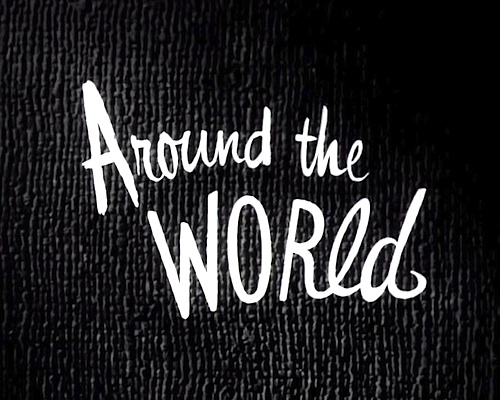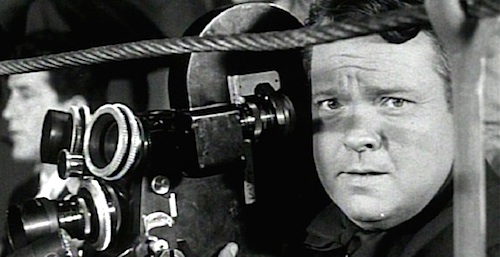 By Joe Bendel. Only Orson Welles cold win a Peabody for a television pilot that never went to series. That would be The Fountain of Youth, produced by Desi Arnaz. As he did in film, Welles burned TV bridges on both sides of the Atlantic. At least six episodes of his British travel series were produced and eventually aired on the fledgling ITV. Twenty-six had been commissioned, but they were probably lucky to get what they got, for reasons Welles fans know only too well. Little seen at the time of their original broadcast, all six episodes are now available for streaming as part of Fandor’s Orson Welles collection, assembled in celebration of the filmmaker’s centennial.
By Joe Bendel. Only Orson Welles cold win a Peabody for a television pilot that never went to series. That would be The Fountain of Youth, produced by Desi Arnaz. As he did in film, Welles burned TV bridges on both sides of the Atlantic. At least six episodes of his British travel series were produced and eventually aired on the fledgling ITV. Twenty-six had been commissioned, but they were probably lucky to get what they got, for reasons Welles fans know only too well. Little seen at the time of their original broadcast, all six episodes are now available for streaming as part of Fandor’s Orson Welles collection, assembled in celebration of the filmmaker’s centennial.
Orson Welles will be our host, as well as the director and primary cameraman and editor. You might pick up a little something about each port of call, but the series will never replace your Fodor’s or Let’s Go. It’s all about Welles, but isn’t it always?
The first episode assembled into the Around the World super-cut is probably the most Wellesian. It is here in Basque Country that we most often see his dynamic sense of composition. Of course, it is hardly surprising that Welles was inspired by the locals’ defiant refusal to quietly conform to either France or Spain. He also clearly had a great deal of affection for his appointed translator, Chris Wertenbaker, the young son of his recently deceased friend, Time foreign correspondent Charles Wertenbaker.
If you were charmed the first “Pays Basques I” than hopefully you will also will also enjoy the network-edited “Pays Basques II,” which includes the same intro and conclusion, but comes with a lot more Pelote (the Basque game related to Jai alai) in between. Still, Welles’ easy rapport with Wertenbaker and all the little moppet Pelote prodigies is quite engaging.
Probably the one episode most likely to disappoint is “Return to Vienna.” By its very title, it promises to revisit the memorable backdrops of Carol Reed’s The Third Man, but Welles spends most of his time in the city’s elite pastry shop. Evidently that was what he most remembered from his time in Vienna. Still, it is nice to be able to finally see it for ourselves. Like many works of Welles marginalia, “Return” was presumed lost for years.
Continuing on to Paris, Around gets a bit impressionistic with “St.-Germain-des-Prés.” Welles spends a lot of time wordlessly panning the streets of the Left Bank hipster enclave. A lot of famous French intellectuals, including Jean Cocteau and Juliette Gréco make cameo appearances, but Welles only talks at length with Raymond Duncan, Isadora’s sandal making, Greek tunic-wearing brother. He and Welles get on pretty well too.
In one sense, Welles was really phoning in the London episode, since he spends half the episode talking to the widows living in the Anglican charity houses next door to theater where he was mounting his ill-fated production of Moby Dick—Rehearsed. On the other hand, that old Welles charm really comes through as he flirts with his eighty and ninety year old neighbors, all whom declared themselves to be “true blue” Tories, who must be besides themselves with glee up in Heaven watching the pasting David Cameron just laid on Ed Millibrand. For the second half of the show, Welles knocks back a few pints with a few of retired soldiers living in the Royal Hospital Chelsea (hospital in this case meaning a place of hospitality). Again, the old salty dogs appreciate Welles’ good fellowship (and his hollow leg).

For the bullfight report in Madrid, Welles enlists Kenneth Tynan and Elaine Dundy as surrogate hosts. She is relatively relaxed, but he had no business being on camera at this point in his career. As was always the case, Welles’ commentary was recorded after the fact. In some cases, it certainly looks like he took advantage of the opportunity to make contentions his guests never had a chance to refute (but he always seems to faithfully represent his conversations with the pensioners). With only one camera, this was sort of a necessity. Still, what could be considered highly problematic liberty-taking for anyone else, comes across as Welles’ likable roguishness here.
Frankly, there is always room for more Orson Welles projects in the world, especially those that are more or less finished. With Around we can see Welles start to understand that being Orson Welles was a form of performance art in itself. There are more than enough fascinating moments at each stop (particularly in Basque Country and London) to make Around the World a rewarding way to spend nearly three hours. Recommended for Welles fans looking for more, Around the World is now available for Fandor subscribers as part of its Welles collection (along with his intriguing but fragmentary Too Much Johnson).
LFM GRADE: B-
Posted on May 28th, 2015 at 9:53pm.